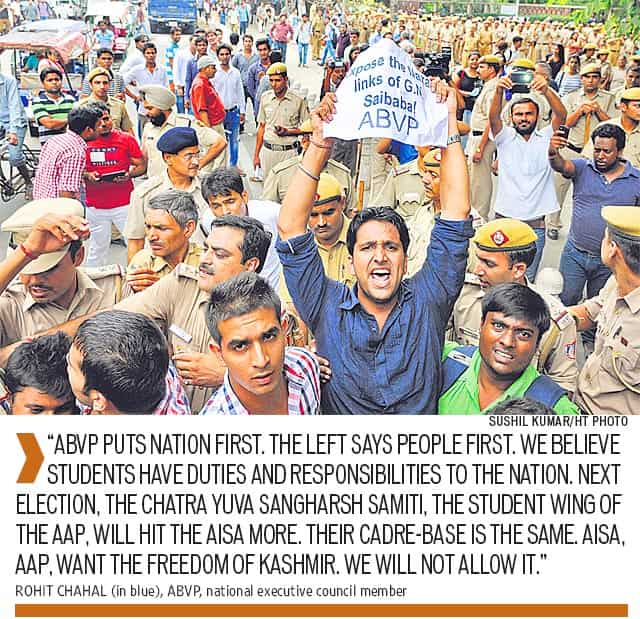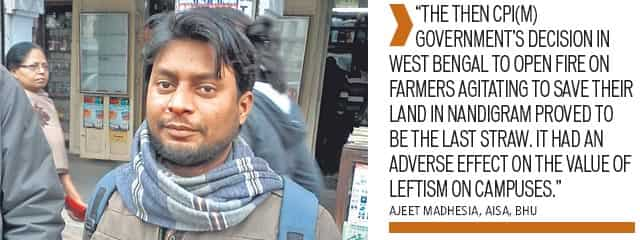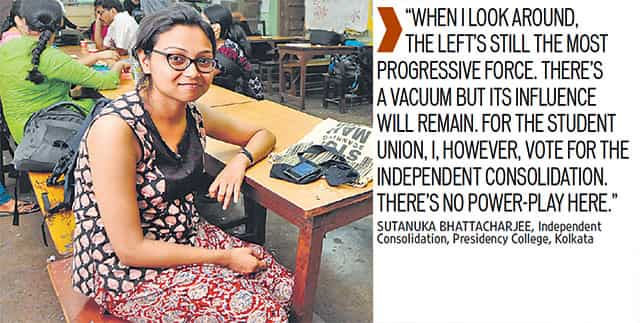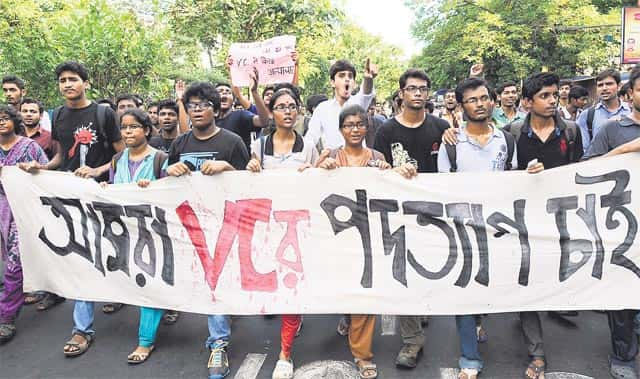Is Left still 'cool' on campus or has Right's rise changed that?
The Left has always drawn its members from student unions. But is the Left still 'cool' on campus or has the rise of the Right changed that?
On the first of May, around 200 workers of JNU, frustrated by job insecurity, put some people in a spot. To the contractors, they said 'To hell with contractualisation; you can keep our jobs'. To party leftists, who came to shut them up for raising slogans hours too early for the evening's May Day parade, they gave an earful. Left-wing students, who no longer belong to an organisation, however, backed their stand. The campus belongs to all, they said. "Should the Left appear militant and mobilise workers and students only during elections?" they asked.

What does this little May Day incident reveal about the state of leftism on India's campuses when it's viewed against the backdrop of the elevation of Sitaram Yechury to the post of general secretary of India's largest left party? That it is a spent force? That it has the potential to take a new turn? That the BJP's student's wing, the Akhil Bharatiya Vidyarthi Parishad (ABVP), has the numbers, therefore it is winning? Or that caste-based student groups dominate in the states where their umbrella-parties are in power, and on those campuses, both, the Left and the Right have influence, but neither is winning?
This story goes back at least 10 years, when the Students' Federation of India (SFI), the student wing of the Communist Party of India (Marxist), and the All India Students' Association (AISA), the student front of the Communist Party of India (Marxist-Leninist)-Liberation, had just begun their war games to appear as the campus radical without noticing the shifts on ground.
Martand Pragalbh, a student from Patna, joined AISA in 2006, the year he joined JNU, Delhi. In Kolkata, research scholar Sourav Ghosh, joined Jadavpur University (JU)'s SFI unit in 2007. Within a year, Sourav, criticised for the "elitist act" of joining a placement-cell rally, had been witness to state repression unleashed on JU students, and the Nandigram-Singur fiasco. In the absence of his party's engagement with his core issues as a student, and the precarity that comes with it in these times, he left the SFI; like many others. He is now with the Forum for Arts Students, a multi-ideological student formation without any party affiliation.

Sourav's JU mate and SFI activist Srijan Bhattacharjee, however, points to the "literacy rate of 99.4% like Bradman's average…and record rice production in 2011 under the Left Front". But Sourav seems unlikely to return to his old organisation on these counts.
By mid-2000, the AISA, more than the ABVP, began to emerge as the SFI's opposition on north Indian campuses, mainly JNU. Doing the commonsensical 'anti-violence' critique of Maoists, and slamming the SFI for the ills of the post-Nandigram CPI(M), AISA saw a proliferation of caste-based and splinter leftist groups on north Indian campuses - an offshoot of the ban on student elections by the Lyngdoh Commission - even while it was on the ascendant. In 2008-10, the organisation went to Delhi High Court to remove obstacles in the path of OBC reservation in JNU. It also started using caste identity and the politics of representation to make space for Dalits, women and Muslims in the different school panels on campus.
In Allahabad University - AISA was first founded there in 1990 - it would "talk against caste politics, but not exactly shy away from caste-based campaigning to get votes," admits Vishwa Deepak, a long-time AISA supporter. This embarrassed its own workers much like the SFI in West Bengal without even the SFI's excuse of being the student appendage of a party (CPI-M) gone bad holding state power.
It is these confusions and contradictions that have withered the Left parties more. That's in addition, of course, to the gravitation of Indian society towards the Right. After the Babri Masjid demolition in the Nineties, and the sustained campaign by the RSS on cultural fronts culminated in the 2014 polls that saw, for the first time, a BJP-majority government in power at the Centre, the BJP's student wing has grown stronger. As Banaras Hindu University (BHU) AISA activist Ajeet Kumar Madhesia says: "Jo dikhta hai, woh campus mein bikta hai (The one who is visible, sells)."

In BHU, a socialist bastion till the Nineties, the ABVP now has 5,500 members, the AISA has 1,200, the Congress' National Students' Union of India (NSUI) 1,000, and the Samajwadi Chattra Sabha, the student wing of the Samajwadi Party, around 200. It's only in Kerala that the CPI(M) still has a strong presence and controls more than 60% of students' union bodies. Kerala has more than 13 lakh SFI members - a figure that might owe much to the party's 'mid-term correctives'. These include involving SFI students with the larger community by making them work after college hours in areas like palliative care and organic farming under the aegis of local panchayats. However, the party's reach does not extend to the state's proliferating private colleges. SFI state secretary TP Bineesh blames the private college students' "apoliticality" for their lack of participation.
They might not be a force in Kerala but in the north, the nature of the educational institution hasn't hobbled the BJP's student wing. "The ABVP has a presence even in colleges where there are no elections. We put nation first," says Rohit Chahal, national executive council member, ABVP, articulating his organisation's agenda. So does the Left put nation last? "It is against the army. It may not put nation last, but it says people first. We believe students are not of tomorrow but of today, they have duties and responsibilities to the nation. Last election, the AISA student-activists even went to Varanasi to support Arvind Kejriwal against Narendra Modi. The AISA, AAP want the freedom of Kashmir. We will not allow anyone to get it easily."
TALKING BACK
Things have been growing progressively difficult for Left student unions since the 1990s when the Soviet Union split, the Eastern bloc collapsed, Tiananmen was crushed and the party began to take a beating nationally. Fast forward to the 2000s: at home, the CPI(M)-led Left Front lost West Bengal after more than three decades in power; in the Opposition, what land or factory question could it possibly take up after Nandigram?
In 2011, its ideological bankruptcy was exposed when, after its rout by the Trinamool Congress, many SFI units - Bidhannagar College's SFI is one of them - became TMC overnight. The options before it were to break new ground or revive the party by consolidating in places where it once held sway.

(Samir Jana/ HT Photo)
Caste became, at least for the AISA (now the more visibly radical force minus the taint of governance), the ground for organisation and party-building. In Punjabi University, Patiala, for instance, the Punjab Students' Union, the students' wing of the CPI(ML)-New Democracy, raises demands such as the implementation of scholarship schemes for poor Dalit students. The AISA, however, began to feel destabilised by the form and culture of the UGBM (University General Body Meeting) that suddenly captured the imagination of students in the mid-2000s. At these GBMs, students, who were unwilling to abandon leftist politics, began to urge their organisation to go beyond 'fixing' the system's problems with representation (of women, Dalits, religious and sexual minorities) and challenge the structure of social division itself.
"The Left, if it wants to make its radicalism relevant, must comprehend what it has until now been largely confused about. It must realise that caste, religion, gender and sexuality are various forms through which the system perpetuates its one single logic of class division," says Pratyush Chandra, a Left analyst and former CPI student leader of JNU.
NEW PATH
Students seem to want to move away from a top-down structure of unions and decide the digits of politics that arise organically from the everyday concerns of students. "On campuses, we need to think of the student as an academic worker and envisage the questions of his life and livelihood as a political ground for changing the systems, rather than just use those questions to mobilise students for building party-like organisations," says Martand Pragalbh who recently quit AISA on these questions. "For that we need to figure out how all the different divisions (of hostel/disciplines/teacher-student hierarchy) on campus hold the potential for generating struggles to radically alter the system. That is what Left students' politics must be now," he adds.
A growing number of students seem to be in search of a new path. The 'Hok Kolorob' (Let's Clamour) movement started by JU students in 2014 to protest the apathy of the university administration to a case of molestation has pointed to the possibilities for independent politics on campus. More than one lakh people marched in the city to its call last September. It would seem that in states with a Left tradition, the framework for 'independence' is still left-oriented. The Independent Consolidation (IC), the leading force in the student politics of Presidency College (now University) also has a left-wing orientation.

(Subhankar Chakraborty/ HT Photo)
"The IC is ideologically left but not pro-CPIM or pro-Left Front government," clarifies Deborshi Chakraborty, ex-convenor, IC. "Arab Spring, Occupy, Hok Kolorob signify a new wave of student-youth movements distinct from doctrinaire Marxism or the co-opted Left".
It is this space that Prasenjit Bose, former head of the research cell of the CPI(M) and ex-SFI leader is trying to consolidate. He resigned from the party in 2012 protesting the Party's political "deviations" and his Left collective mobilises youth and raises issues left unaddressed by the party Left. Bose attributes the SFI's decline from the mid-2000s to the "erosion of the independent character of the SFI." He had questioned the way "Left unity" was being imposed from top without any course correction in the CPIM.
The recent six-party Left coalition, which has the CPI(M) and CPI(ML)-Liberation as part of a national alliance, says Bose, is an attempt to co-opt the left critiques of the CPI(M) and silence them. What this means for the student cadres in the SFI and the AISA, is uncertain. The AISA, say students, is poised to be the "new SFI". But what of the various independent, "post-party" initiatives being produced by continual dissensions in the rank and file of the party Left? Will that be India's new Left? Time will tell.
Inputs: K Sandeep Kumar/Allahabad, Pawan Dixit/Varanasi, Ramesh Babu/Thiruvananthapuram, Prabhjit Singh/Mohali
* With the SFI in decline in the 2000s, AISA emerged as the leading left student organisation in JNU, the left bastion
* AISA was founded in the Union Hall of the Allahabad University in 1990. Now, the ABVP has around 18,000 members in the city's colleges while AISA has around 2,000
* Punjabi University, Patiala, has the strongest Leftist presence in Punjab
* SFI controls more than 60 per cent of universities and college student union bodies in Kerala
* ABVP has 44 lakh aprox members across India; It has around 40,000 in Delhi





